Index :
- About The Indian Navy
- Why do we need The Indian Navy?
- Ranks and Insignia of The Indian Navy
- Joining Positions and eligibility
- How to join?
- Benefits of joining
- Life inside Navy
- Life after Navy
About The Indian Navy
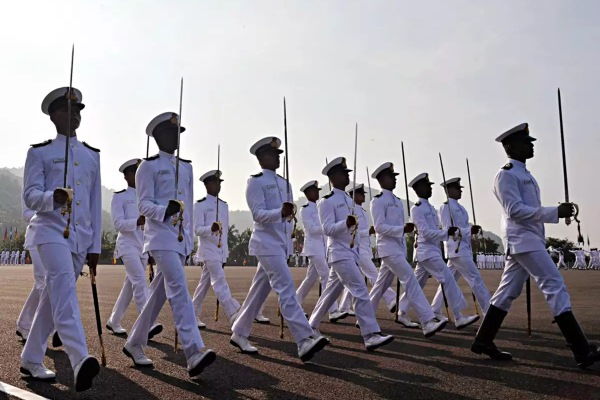
The Indian Navy has three commanding zones, namely, The Eastern Naval Command, The Western Naval Command, and The Southern Naval Command.
- The Western Naval Command: The headquarters of The Western Naval Command is located in Mumbai. It has authority over the Arabian sea. This is an operational command i.e. they exercise authority to take actions.
- The Eastern Naval Command: The headquarters of The Eastern Naval Command is located in Visakhapatnam. This is an operational command and exercise authority over the bay of Bengal related matters.
- The Southern Naval Command: The headquarters of The Southern Naval Command are located in Kochi. This command is a training command instead of being operational like the other two commands.
The Indian Navy is in command of Chief of the Naval Staff which exercises command together with the defense ministry. There is a Vice Chief of the Naval Staff along with three other Principal Staff Officers.
The Indian Navy has two fleets called the Eastern and Western Fleet located at Visakhapatnam and Mumbai respectively. The Indian Navy also covers islands under Indian Governance such as Andaman and Nicobar islands. The flotillas of The Indian Navy provide security in their respective regions. The Naval Officer – in charge (NOICs) has the authority to make decisions regarding territory under them.
The Indian Navy takes care of all the national interests. The Indian Navy is full of diligent and vigilant staff.
Why do we need The Indian Navy?
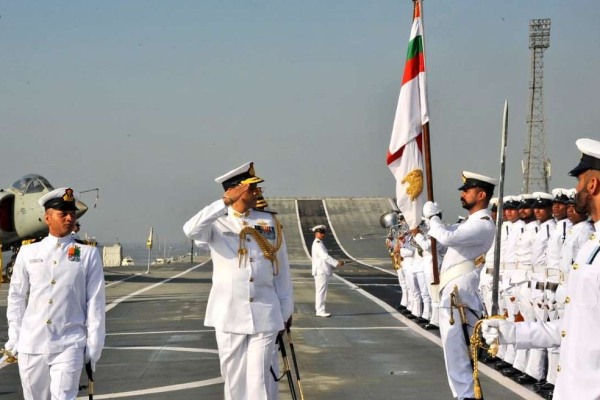
To secure our land we need to excel at sea level operations. India has a long coastline along with several islands in the vast sea, under its territory. As a developed country, India is under threat for numerous reasons, The Indian Navy makes sure that the homeland of our country is safe.
Under natural calamities and emergencies, The Indian Navy has been called time and time again. That’s why The Indian Navy requires enthusiastic, ethical, energetic, diligent Naval staff.
The ranks and insignia in The Indian Navy
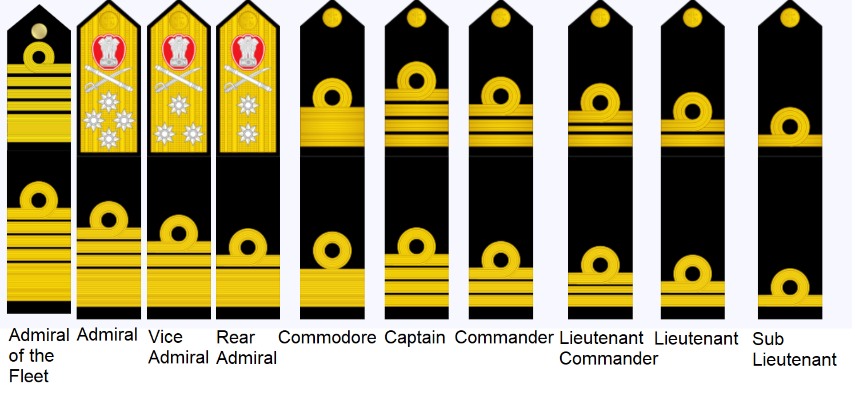
The Navy staff has officer ranks and sailor ranks. The rank depends on whether you are serving the Indian Navy as an officer or as a sailor.
Officer Ranks in descending order :
- Admiral
- Vice Admiral
- Rear Admiral
- Commodore
- Captain
- Commander
- Lieutenant Commander
- Lieutenant
- Sub Lieutenant
- Midshipman
Sailor Ranks in descending order :
- Master Chief Petty Officer 1st Class
- Master Chief Petty Officer 2nd Class
- Chief Petty Officer
- Petty Officer
- Leading Rate
- Seaman 1st Class
- Seaman 2nd Class
Personnel who join as sailors can become commissioned officers if they have the required qualifications and unique leadership qualities. This opportunity is given by The Indian Navy to sailors who couldn’t join as officers due to some reasons. This helps sailors with exceptional qualities to join the officer’s rank.
Why join The Indian Navy?
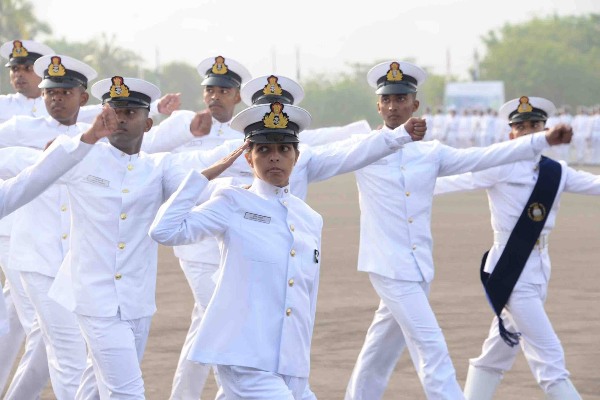
The Indian Navy Provides a myriad number of opportunities for a person to become a better version of themselves. You grow in every aspect of life, leadership qualities, crisis management, resource management. Life in The Indian Navy teaches you all.
You get to experience life at sea. You get to make decisions that matter, you serve your country and keep its citizens safe. The challenges faced in the sea brings out your full potential. You have the responsibility of your team and the security of our country. In the time of crisis, our forces are required for most of the rescue operations. Joining Navy means serving your country and serving your people.
Your leadership quality burgeons as you get to lead a team of staff, technologies and complex missions. You adapt to the circumstances and try to make the best out of it. If you serve the navy once, you can survive at anything in life.
The coolest technologies, with Hitech ships and submarines, you experience the sea life from another perspective. It’s not just some 9 to 5 job, it’s more than just an income, the experiences you go through are priceless. So if you want to make a difference join The Indian Navy.
Joining positions in Indian Navy:
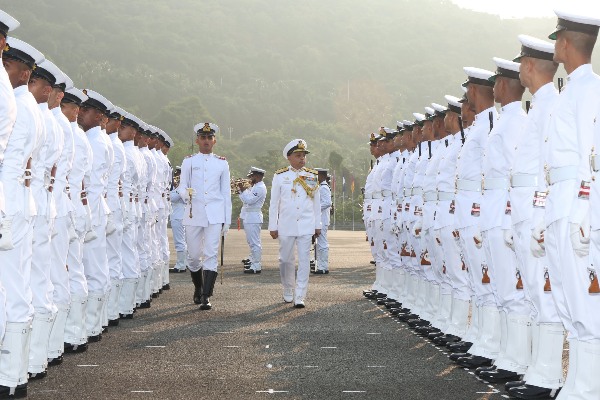
Any candidate can join the Indian Navy as an officer, sailor or naval civilian. A candidate can check their eligibility on the official website of the Indian Navy.
1. Officers have five different departments:
- Executive: Executive officers can work in general service, pilot, hydro, observer, logistics, NAIC, Information Technology, Atc, law, sports, and musician.
- Electrical: Electrical officers can work in a submarine or general services.
- Education: The education officers train world-class naval officers, for The Indian Navy. They mainly deal with new candidates and turn them into proud naval officers.
- Engineering: Engineering officers can work in general services, submarine, and naval architecture.
- Medical: Navy provides a great platform to medical officers. The officers receives all the perks of retirement, great pay scale, insurance and many more. The Navy operates its medical services through a chain of defense hospitals spread across the country.
2. Sailors have different departments as well such as:
- Artificer Apprentice: An artificer goes through one of the best training to become a sailor. You learn how to manage a team and complex systems with sophisticated equipment in the sea.
- SSR: You get to work with the best technological devices. Your work as a sailor in powerful modern ships and submarines.
- Matric Recruit (MR): You can work as chef(MR), steward(MR) or sanitary hygiene(MR) and your duties will be cooking according to the menu, serve food in officers mess or cleaning the premises respectively.
- Musicians: The personnel is required to perform musical acts during official parades and programs.
How to Join Indian Navy?

You can join the Indian Navy as an officer, sailor or naval civilian. All three categories have different procedures for recruitment.
1. Officer
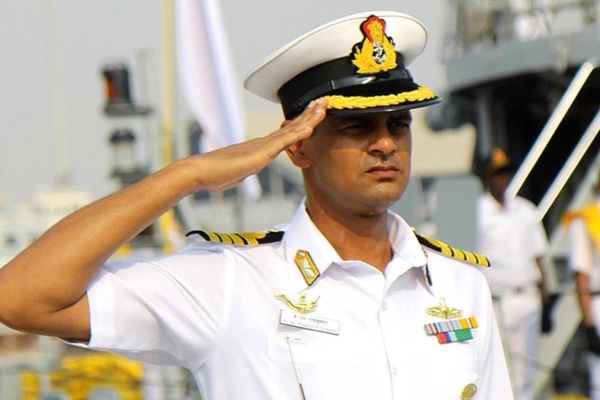
There are several ways to join the Indian Navy as an officer :
1. National Defence Academy (Navy) and National Defence Academy (Naval Academy)
The entry through NDA is controlled by Union Public Service Commission (UPSC) by conducting a written exam followed by an SSB interview. The candidates clearing both the stages go through a medical test by The Indian Navy and a final merit list is declared by the UPSC. IHQ MoD/DMPR issues the appointment letter.
Tentative dates:
- NDA (I) – April the notification comes during January/February
- NDA (II) -October/November the notification comes during June/July
2. Combined Defence Services Exam (CDSE)
The entry through NDA is controlled by Union Public Service Commission (UPSC) by conducting a written exam followed by an SSB interview. The candidates clearing both the stages go through a medical test by The Indian Navy and a final merit list is declared by the UPSC. IHQ MoD/DMPR issues the appointment letter.
Tentative dates:
CDSE (I) – February/March
CDSE (II) – October/November
3. NCC Entry
The vacancies for Naval Wing Senior Div NCC ‘C’ certificate holders are notified along with CDSE notification. The candidates should hold a B.E/B.Tech degree. No written test is conducted and selected candidates are sent straight for SSB. The selected candidates are then sent for a medical examination conducted by The Indian Navy. The final merit list is prepared by examining every aspect of the candidate.
4. Direct Entry
Permanent Commission For Undergraduate level: The applicant should be 12th pass with a minimum of 70% in PCM and more than 50% in English, in both 12th and 10th. JEE mains marks are compulsory to apply through this method. The candidates are selected based on AIR for SSB. The JEE (mains) marks are only applicable till 1 year of result declaration. On completion of SSB, a merit list is prepared and candidates are selected according to the merit.
5. Direct Entry – Permanent Commission For Graduate Level Entries
The direct entries are controlled by IHQ-MoD(Navy)/DMPR and candidates can apply for Short Service Commission(SSC) and Permanent Commission (PC). The candidates are examined for their ability in sports and music and selected candidates are sent for the SSB. The selected candidates are then sent for a medical examination conducted by The Indian Navy. The candidates are selected based on the merit list.
6. Indian Navy Entrance Test (INET)
It is the officer level entry test controlled by IHQ MoD (Navy)/ DMPR and candidates can apply for Short Service Commission(SSC) and Permanent Commission (PC). It is conducted twice a year. Candidates clearing the official cutoff marks are called for SSB interview. A merit list is prepared which gives 50% weightage to INET and 50% weightage to SSB.
7. University Entry Scheme:
These UES entries are controlled by IHQ MoD (Navy)/ DMPR and candidates can apply for Short Service Commission(SSC) and Permanent Commission (PC). It is conducted once a year. Various teams go to different colleges and conduct interviews. The candidates of the 7th sem can appear for the interview if they have more than 60% aggregate marks till the 5th semester. The selected candidates are sent for SSB. Candidates clearing SSB are sent for medical examination and the final selection is done based on the merit list.
2. Sailor
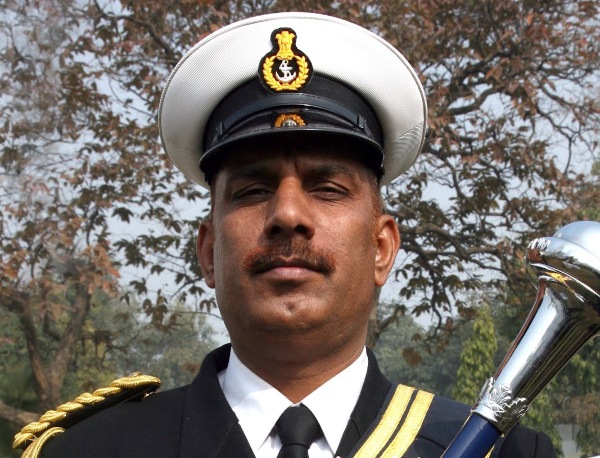
Advertisements are posted on the official Indian Navy website regarding the recruitment of sailors. The application forms for the recruitment are available on the website after the date of notification. Candidates can apply in multiple categories. Each category requires a different application form.
The applicants have to attach the class 10th mark sheet along with the 12th Marksheet/diploma certificate and domicile certificate to the application. The test centers are assigned according to the domicile certificate.
The selected candidates go through a physical test and a medical test.
The candidates can apply for a musician post too. The recruitment notifications are advertised in the newspapers, the candidate has to be proficient in playing a musical instrument (strings, keyboard, etc). Except for this, the selection procedure is the same as the normal sailor application.
Benefits of joining:
Following are the benefits for Officers in Indian Navy:
- Pay: The pay scale in the Indian Navy ranges from INR 50000 to 200000 depending on the rank and years of service.
- Insurance: The Indian Navy provides each of its officers with life insurance of around 50 lakhs.
- Travel: The officers receive 60 days’ annual leave and 20 days casual leave. Officers can accumulate their leaves and encash them during retirement but the accumulation of leaves has an upper limit. The family of the officer gets one free trip (traveling costs) and there are 6 traveling concessions.
- Retirement: All the SSC receive gratuity while all the PC receive a pension after retirement. In case of the unfortunate death of an officer, the spouse receives the pension.
Life inside The Indian Navy:

On duty in the sea, you are responsible for a lot of duties and you utilize numerous skills you learned during your training at the academy. You’ll travel the world and go to places you’ve only seen pictures of. Although ships have home ports where ships are ‘parked’ and you will spend some time close to the shore too. Each personnel has its bed and locker and there are games and tv available in the common area.
Navy takes care of your family when you are out on the service. Your family gets world-class healthcare facilities along with the best education. You get daily necessities in the canteen at affordable prices. The traveling concessions are just one of the perks out of many which make life in the Navy full of stability. The satisfaction of serving your country is immense.
Life after The Indian Navy:

Even after retirement, you will be in the best shape for civil employment. You would have acquired plenty of skills during your service in the Navy that civil employment will be an easy task for you. Your punctuality, decision making, and leadership skills will shine during your life after the Navy. The bonds you make on service with fellow Navalmans will be life long.










